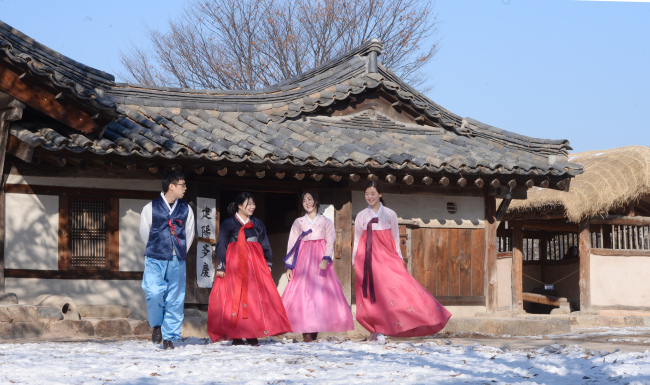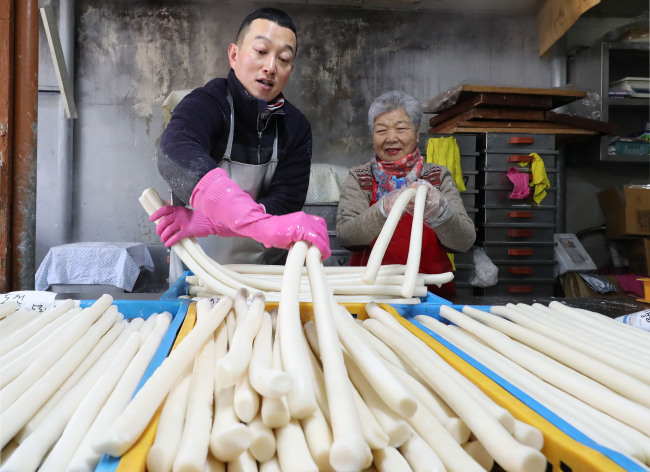A scene that may seem weird or unique to foreign bystanders is the common ritual in South Korea to celebrate the Lunar New Year: younger family members make a full bow, or saebae, to their elders, as they receive envelopes -- of cold, hard cash -- as gifts carrying messages of the best wishes for the future.
As relatives gather for the Seollal holiday, usually at the home of the “highest-ranking” member of the extended family, they dress in neat garments, sometimes traditional hanbok, and take part in a ritual for deceased ancestors, a core of their tradition.
The staple food for the New Year is rice cake soup, or tteokguk, which carries the belief that finishing the bowl makers the person a year older.
All of these celebrations normally take place on Seollal, based on Korea’s long-held lunar calendar.

(Park Hyun-koo / The Korea Herald)
This year, Lunar New Year’s Day falls on Friday, with Thursday and Saturday also designated as official holidays based on the three-day legal holiday rule.
The more widely recognized New Year, or solar New Year’s Day on Jan. 1, is an unlikely choice for Koreans’ celebration, since the government only allots Koreans a one-day public holiday.
While Lunar New Year is definitely a more feted celebration here, it has only been a few decades since Korea gave it legal recognition, following a century of being forced to discard the lunar calendar.
Koreans in the past are said to have celebrated the Lunar New Year during the Silla Kingdom (57 BC-AD 935) as excerpted in traditional Chinese literary works, such as “Book of Sui.”
The traditional celebration, however, faced changes in 1896, when the Joseon Dynasty on the Korean Peninsula was in its twilight. The nation officially recognized the solar New Year as a national holiday and embraced the solar calendar, despite the people’s reluctance.
For nearly a century until the 1980s, Korea’s lunar calendar was the target of reform toward modernization and was being phased out.
The rulers in Korea -- from Japanese to Korean dictators -- labeled the Lunar New Year as outmoded, and called it Gujeong, or “obsolete New Year’s Day.”
Instead, Koreans were forced to hold family celebrations on a three-day holiday on the solar New Year, known as Shinjeong.
By 1907, celebrating Lunar New Year was banned. Korea‘s last emperor, Sunjong, under the influence of the pro-Japanese faction, approved the ban. The Japanese rulers instead forced Koreans to celebrate Jan. 1 as a part of cultural assimilation.
In a letter published in the daily newspaper Dong-a Ilbo on Feb. 14, 1924, a writer, presumably a Korean student, lamented not being able to celebrate the Lunar New Year, while describing the, at that point, 10-day solar New Year as a “holiday of theirs.”
“I’ve been waiting for the Lunar New Year to come, but the school does not give us a holiday at all, and instead says it would hold a nonregular exam (on Lunar New Year),” read the letter. “I’m afraid of physical punishment for poor test scores. I just get to forget about celebrating Lunar New Year.”
Little changed despite the arrival of independence from the Japanese.
Syngman Rhee, Korea‘s first president, recognized the solar New Year as a national holiday in 1949, from Jan. 1 to Jan. 3, although celebrating Lunar New Year was no longer banned. Both solar and Lunar New Year holidays coexisted then.
Park Chung-hee, who assumed the presidency in 1961, took it a step further, by effectively removing the Lunar New Year holiday from among the public holidays the next year. Park reportedly cracked down on rice cake mills -- which produce the main ingredient for tteokguk -- during the Lunar New Year season. Park’s move was meant to discourage the public from the celebrating the New Year twice, which he believed was disruptive to the spirit of Saemaul Undong -- the public enlightenment movement.

(Yonhap)
Debates persisted among Koreans who wished to reinstate their tradition of celebrating the Lunar New Year as a symbol, particularly away from the remnants of the Japanese colonial rule and dictatorship.
After years of tug-of-war on whether to legally accept Lunar New Year in the early 1980s, the Chun Doo-hwan administration in 1985 decided in a Cabinet meeting to give the first day in the lunar calendar a 1-day legal holiday. From then on, Lunar New Year’s Day was called Folk’s Day.
It took another four years for the Lunar New Year to gain its current name Seollal, along with the three-day holiday status, in 1989, as the solar New Year holiday was reduced to two days.
Local newspaper Kyunghyang Shinmun in a Feb. 4, 1989 edition depicted it as a “reinstatement of the nation’s largest holiday.”
The Dong-a Ilbo called it “an unprecedentedly festive atmosphere” where workers in companies were encouraged to go on leave during the Lunar New Year holiday in a Feb. 4, 1989 report, while highlighting the Transport Ministry’s efforts to brace for the largest-ever flow of people across the nation -- estimated to be 17 million, up 20 percent from the previous year.
This came a year after a survey by Gallup Korea showed that 84 percent of people here celebrated Lunar New Year, while only 11 percent of respondents celebrated the solar New Year.
In 1999, the solar New Year’s holiday was reduced to one day on Jan. 1. With Korea reeling from the impacts of a financial crisis, the former Kim Dae-jung administration did not allow a holiday to workers in public organizations on Jan. 2, marking a complete transition of the New Year‘s holiday status to the Lunar New Year.
By Son Ji-hyoung
(
consnow@heraldcorp.com)






![[KH Explains] How should Korea adjust its trade defenses against Chinese EVs?](http://res.heraldm.com/phpwas/restmb_idxmake.php?idx=645&simg=/content/image/2024/04/15/20240415050562_0.jpg&u=20240415144419)
